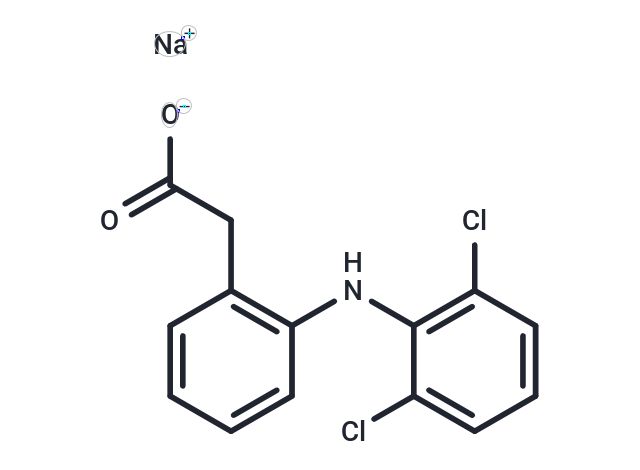Shopping Cart
- Remove All
 Your shopping cart is currently empty
Your shopping cart is currently empty

Diclofenac sodium (GP 45840) is a non-steroidal anti-inflammatory agent (NSAID) with antipyretic and analgesic actions. It is primarily available as the sodium salt.

| Pack Size | Price | Availability | Quantity |
|---|---|---|---|
| 500 mg | $45 | In Stock |
| Description | Diclofenac sodium (GP 45840) is a non-steroidal anti-inflammatory agent (NSAID) with antipyretic and analgesic actions. It is primarily available as the sodium salt. |
| Targets&IC50 | COX-2:200 nM, COX-1:60 nM |
| In vitro | Diclofenac inhibits Wnt/beta-catenin signaling without altering the level of beta-catenin protein and reduces the expression of beta-catenin/TCF-dependent genes. Diclofenac induces the degradation of IkappaBalpha, which increases free nuclear factor kappaB (NF-kappaB) in colon cancer cells. [1] Diclofenac suppresses both fast tetrodotoxin-sensitive (TTX-S) and the slow tetrodotoxin-resistant (TTX-R) sodium currents in a dose-dependent manner. Diclofenac produces shifts of the steady-state inactivation curves in the hyperpolarizing direction in both types of sodium currents in a dose-dependent manner. Diclofenac may bind to sodium channels with a greater affinity when they are in the inactivated state than when they are in the resting state. [2] Diclofenac results in a severe accumulation of protein in the tubular cells (so called hyaline droplet degeneration), macrophage infiltration and structural alterations (dilation, vesiculation) of the endoplasmic reticulum (ER) in the proximal and distal renal tubules of kidney. Diclofenac also results in shortening of podocytes and their retraction from the basal lamina, a thickening of the basal lamina, the formation of desmosomes, and necrosis of endothelial cells in the renal corpuscles of kidney. [3] |
| In vivo | Diclofenac (0.01 to 0.2 mM) stimulates state-4 respiration and slightly inhibits state 3 in rats, decreasing the respiratory control ratio, while the membrane potential is decreased or collapsed (depending on the drug concentration). [4] |
| Alias | GP 45840 |
| Molecular Weight | 318.13 |
| Formula | C14H10Cl2NNaO2 |
| Cas No. | 15307-79-6 |
| Smiles | [Na+].C(=O)(Cc1c(cccc1)Nc1c(cccc1Cl)Cl)[O-] |
| Relative Density. | 0.781 g/cm3 |
| Storage | Powder: -20°C for 3 years | In solvent: -80°C for 1 year | Shipping with blue ice. | ||||||||||||||||||||||||||||||||||||||||
| Solubility Information | DMSO: 45 mg/mL (141.45 mM), Sonication is recommended. H2O: 15.9 mg/mL (49.98 mM), Sonication is recommended. | ||||||||||||||||||||||||||||||||||||||||
Solution Preparation Table | |||||||||||||||||||||||||||||||||||||||||
H2O/DMSO
DMSO
| |||||||||||||||||||||||||||||||||||||||||

Copyright © 2015-2025 TargetMol Chemicals Inc. All Rights Reserved.